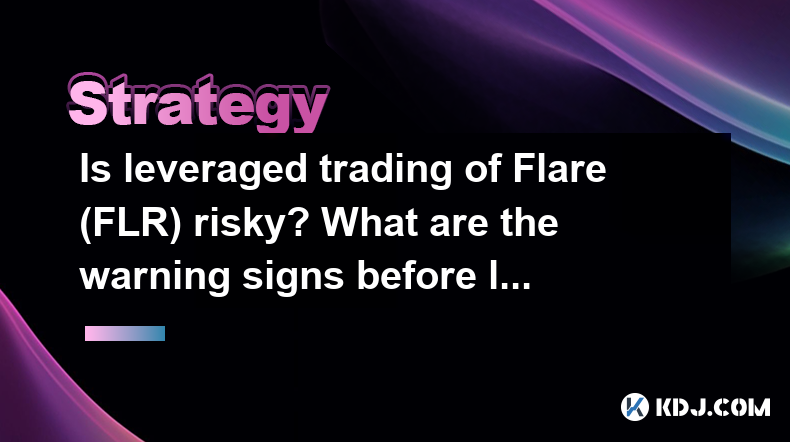-
 bitcoin
bitcoin $108842.957301 USD
-1.88% -
 ethereum
ethereum $3931.777121 USD
-1.66% -
 tether
tether $1.000186 USD
-0.03% -
 bnb
bnb $1153.250882 USD
-2.20% -
 xrp
xrp $2.367904 USD
-1.94% -
 solana
solana $186.182050 USD
-4.20% -
 usd-coin
usd-coin $0.999997 USD
0.00% -
 tron
tron $0.316949 USD
-1.00% -
 dogecoin
dogecoin $0.190780 USD
-3.12% -
 cardano
cardano $0.651324 USD
-2.67% -
 hyperliquid
hyperliquid $37.141055 USD
-0.85% -
 ethena-usde
ethena-usde $0.999224 USD
-0.09% -
 chainlink
chainlink $17.579031 USD
-2.47% -
 bitcoin-cash
bitcoin-cash $509.426284 USD
-2.79% -
 stellar
stellar $0.315298 USD
-2.93%
Is leveraged trading of Flare (FLR) risky? What are the warning signs before liquidation?
Leveraged trading of Flare (FLR) is risky due to market volatility; watch for price drops and margin calls to avoid liquidation. Use stop-loss orders to mitigate risks.
May 05, 2025 at 12:08 am

Is leveraged trading of Flare (FLR) risky? What are the warning signs before liquidation?
Leveraged trading of cryptocurrencies like Flare (FLR) can be an exhilarating yet risky endeavor. The allure of potentially high returns draws many traders into the world of leverage, but it's crucial to understand the inherent risks involved. Leveraged trading involves borrowing funds to increase the size of a trade, which can amplify both gains and losses. In this article, we will delve into the risks associated with leveraged trading of Flare (FLR) and discuss the warning signs that traders should be aware of before facing liquidation.
Understanding Leveraged Trading and Its Risks
Leveraged trading allows traders to open positions larger than their actual capital by borrowing funds from the exchange. This is often expressed as a ratio, such as 10:1, meaning for every dollar of the trader's capital, they can control $10 worth of Flare (FLR). While this can lead to significant profits if the market moves in the trader's favor, it also means that losses can exceed the initial investment, leading to a margin call or liquidation.
The primary risk associated with leveraged trading of Flare (FLR) is the volatility of the cryptocurrency market. Cryptocurrencies are known for their price fluctuations, and Flare (FLR) is no exception. A sudden drop in the price of FLR can quickly erode the trader's margin, leading to a margin call where the exchange demands additional funds to maintain the position. If the trader cannot meet this demand, the position will be liquidated, potentially resulting in significant losses.
Factors Contributing to the Risk of Leveraged Trading FLR
Several factors contribute to the risk of leveraged trading Flare (FLR). Market sentiment plays a crucial role, as positive or negative news can drastically affect the price of FLR. For instance, announcements related to Flare Network's developments, partnerships, or regulatory changes can lead to rapid price movements. Additionally, liquidity is another critical factor. If the market for FLR is not liquid enough, it can be challenging to enter or exit positions without affecting the price, increasing the risk of slippage and liquidation.
Another factor to consider is over-leveraging. Traders often get tempted to use high leverage to maximize potential profits, but this increases the likelihood of liquidation. Using excessive leverage can lead to a rapid depletion of margin, especially in a volatile market. It's essential for traders to assess their risk tolerance and choose a leverage ratio that aligns with their trading strategy and financial goals.
Warning Signs Before Liquidation
Recognizing the warning signs before liquidation is crucial for managing risk in leveraged trading of Flare (FLR). The first sign to watch for is a significant drop in the price of FLR. If the price moves against the trader's position, it can quickly eat into the margin. Monitoring the margin level is essential; most trading platforms display this as a percentage, and a falling margin level indicates that the position is approaching liquidation.
Another warning sign is receiving a margin call. This happens when the margin level falls below a certain threshold set by the exchange, prompting the trader to deposit additional funds or close part of the position to restore the margin level. Ignoring a margin call can lead to automatic liquidation by the exchange. Additionally, increased market volatility should be a red flag. If the market for FLR becomes more volatile, the risk of liquidation increases, especially for positions with high leverage.
Strategies to Mitigate the Risks of Leveraged Trading FLR
To mitigate the risks associated with leveraged trading of Flare (FLR), traders can adopt several strategies. Setting stop-loss orders is one of the most effective ways to limit potential losses. A stop-loss order automatically closes the position if the price of FLR reaches a predetermined level, preventing further losses. It's important to set stop-loss orders at a level that allows for normal market fluctuations but protects against significant adverse movements.
Another strategy is diversifying the trading portfolio. Instead of putting all capital into leveraged FLR positions, traders can spread their investments across different cryptocurrencies and asset classes to reduce overall risk. Regularly monitoring positions is also crucial. By keeping a close eye on the market and the margin level, traders can take timely actions to adjust their positions or add more funds to prevent liquidation.
Practical Steps to Manage Leveraged Trading of FLR
For those engaging in leveraged trading of Flare (FLR), here are practical steps to manage the process effectively:
Choose the Right Exchange: Select a reputable cryptocurrency exchange that offers leveraged trading of FLR. Ensure the platform has robust security measures and a user-friendly interface.
Understand the Leverage Ratio: Before opening a position, understand the leverage ratio and its impact on potential profits and losses. Start with lower leverage to gain experience and gradually increase it as confidence grows.
Set Up Risk Management Tools: Use stop-loss orders and take-profit orders to manage risk. These tools can help protect against significant losses and lock in profits.
Monitor Market Conditions: Keep an eye on market news and events that could affect the price of FLR. Use trading tools and charts to analyze market trends and make informed decisions.
Regularly Review Positions: Check the margin level and overall position regularly. Be prepared to add more funds or close positions if the margin level approaches the liquidation threshold.
Educate Yourself: Continuously educate yourself on leveraged trading strategies and the specifics of Flare (FLR). Understanding the asset and the market can help in making better trading decisions.
Frequently Asked Questions
Q: Can I recover losses after a liquidation in leveraged trading of FLR?A: Once a position is liquidated, the losses are realized, and it's challenging to recover them directly. However, traders can learn from the experience and adjust their strategies to avoid similar situations in the future. It's essential to treat any trading losses as a learning opportunity and not to chase losses with more leveraged trades.
Q: How does the choice of leverage affect the risk of liquidation in FLR trading?A: The choice of leverage directly impacts the risk of liquidation. Higher leverage amplifies both potential gains and losses, making the position more susceptible to liquidation if the market moves against it. Lower leverage provides a buffer against market volatility, reducing the risk of liquidation but also limiting potential profits.
Q: Are there any tools or indicators that can help predict potential liquidation in FLR trading?A: While no tool can predict liquidation with certainty, several indicators can help traders monitor their risk. Margin level indicators show how close a position is to liquidation, while volatility indicators can signal increased market risk. Additionally, technical analysis tools like moving averages and RSI can help identify potential price movements that could lead to liquidation.
Q: What should I do if I receive a margin call while trading FLR with leverage?A: Upon receiving a margin call, you have a few options. You can deposit additional funds to meet the margin requirements, close part of the position to reduce the leverage and restore the margin level, or close the entire position to avoid further losses. It's crucial to act quickly and decide based on your risk tolerance and market conditions.
Disclaimer:info@kdj.com
The information provided is not trading advice. kdj.com does not assume any responsibility for any investments made based on the information provided in this article. Cryptocurrencies are highly volatile and it is highly recommended that you invest with caution after thorough research!
If you believe that the content used on this website infringes your copyright, please contact us immediately (info@kdj.com) and we will delete it promptly.
- Cardano, Dogecoin, and the Token Rally: What's the Hype?
- 2025-10-17 22:45:16
- Milk Mocha Meme Coin: Last Call for Whitelist & Early HUGS Gains!
- 2025-10-17 22:45:16
- Crypto's New Sweetheart: Milk & Mocha's $HUGS Token and the Early Rounds Advantage
- 2025-10-17 22:25:12
- Crypto Picks for 2025: Blazpay Presale and Emerging Trends
- 2025-10-17 22:50:12
- Meme Coins: Riding the Early Bird Gold Rush
- 2025-10-17 23:05:12
- Shannon Man, Cash Prizes, and Coin Games: A New York Minute on a Georgia Arrest
- 2025-10-17 22:50:12
Related knowledge

Practical parameter settings for a Bitcoin multi-timeframe moving average system
Sep 18,2025 at 10:54pm
Optimizing Timeframe Combinations for Bitcoin Trading1. Selecting appropriate timeframes is crucial when building a multi-timeframe moving average sys...

How can I filter out false breakouts in Dogecoin high-frequency trading?
Sep 22,2025 at 01:00am
Understanding False Breakouts in Dogecoin Trading1. A false breakout occurs when Dogecoin's price appears to move beyond a defined support or resistan...

Techniques for identifying tops and bottoms in the Bitcoin on-chain NVT model
Sep 20,2025 at 07:54pm
Understanding the NVT Model in Bitcoin Analysis1. The Network Value to Transactions (NVT) ratio is often described as the 'P/E ratio' of the cryptocur...

What does the surge in open interest in Bitcoincoin futures mean?
Sep 20,2025 at 11:18pm
Understanding the Surge in Dogecoin Futures Open Interest1. A surge in open interest within Dogecoin futures indicates a growing number of active cont...

How can I use the Ethereum USDT premium to gauge market sentiment?
Sep 18,2025 at 11:55pm
Understanding the Ethereum USDT Premium1. The Ethereum USDT premium refers to the price difference between USDT (Tether) traded on Ethereum-based plat...

What should I do if Ethereum staking yields decline?
Sep 20,2025 at 06:18am
Understanding the Causes Behind Declining Ethereum Staking Yields1. The Ethereum network transitioned to a proof-of-stake consensus mechanism with the...

Practical parameter settings for a Bitcoin multi-timeframe moving average system
Sep 18,2025 at 10:54pm
Optimizing Timeframe Combinations for Bitcoin Trading1. Selecting appropriate timeframes is crucial when building a multi-timeframe moving average sys...

How can I filter out false breakouts in Dogecoin high-frequency trading?
Sep 22,2025 at 01:00am
Understanding False Breakouts in Dogecoin Trading1. A false breakout occurs when Dogecoin's price appears to move beyond a defined support or resistan...

Techniques for identifying tops and bottoms in the Bitcoin on-chain NVT model
Sep 20,2025 at 07:54pm
Understanding the NVT Model in Bitcoin Analysis1. The Network Value to Transactions (NVT) ratio is often described as the 'P/E ratio' of the cryptocur...

What does the surge in open interest in Bitcoincoin futures mean?
Sep 20,2025 at 11:18pm
Understanding the Surge in Dogecoin Futures Open Interest1. A surge in open interest within Dogecoin futures indicates a growing number of active cont...

How can I use the Ethereum USDT premium to gauge market sentiment?
Sep 18,2025 at 11:55pm
Understanding the Ethereum USDT Premium1. The Ethereum USDT premium refers to the price difference between USDT (Tether) traded on Ethereum-based plat...

What should I do if Ethereum staking yields decline?
Sep 20,2025 at 06:18am
Understanding the Causes Behind Declining Ethereum Staking Yields1. The Ethereum network transitioned to a proof-of-stake consensus mechanism with the...
See all articles










































































